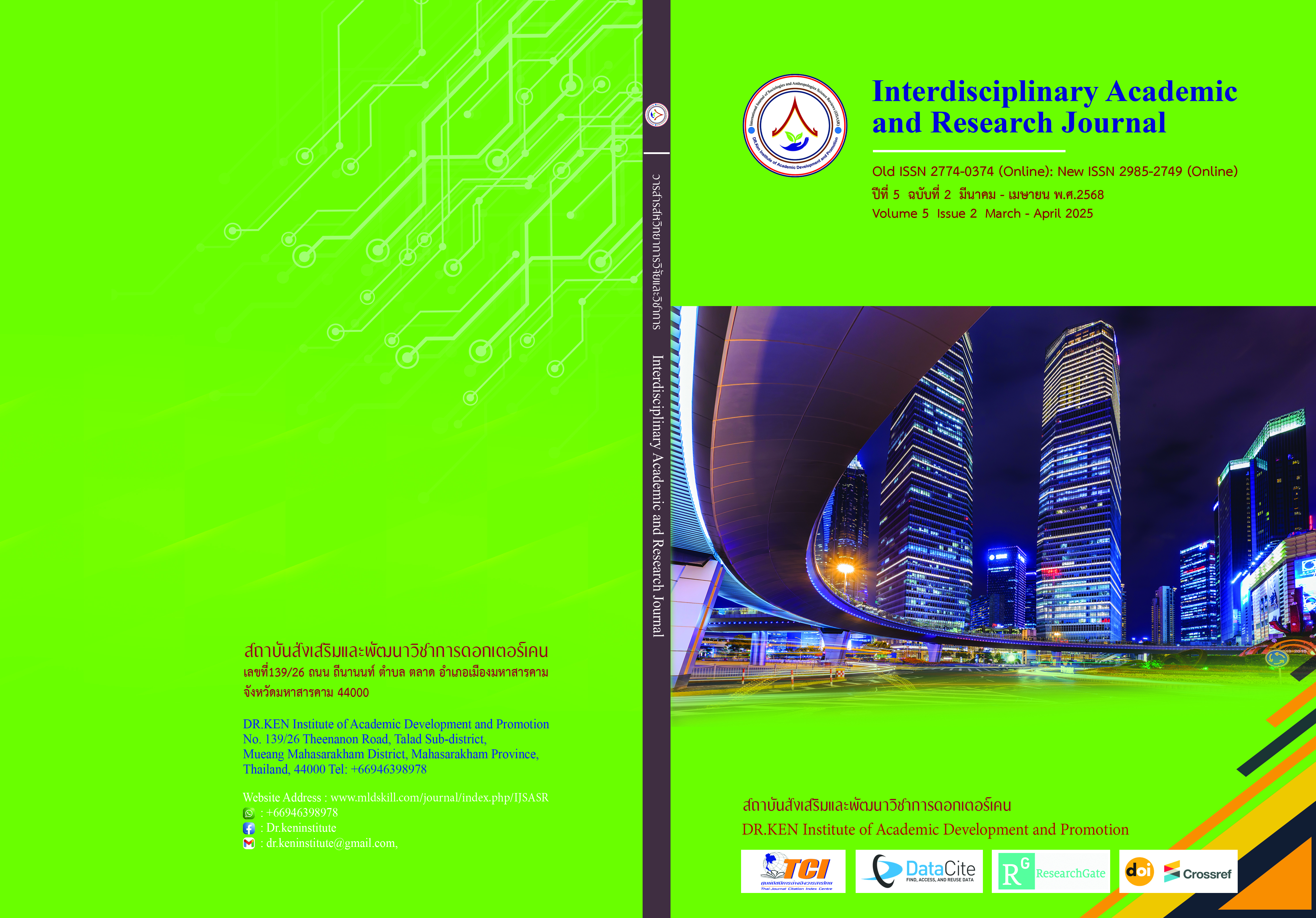Developing A Curriculum in English Speaking for Communication Using Simulation Situations of Second-year Vocational Certificate Students
DOI:
https://doi.org/10.60027/iarj.2025.279943Keywords:
Curriculum Development, Speaking English for Communication Skills, Simulation learningAbstract
Background and Aims: Creating an English-speaking curriculum for communication through simulation situations is critical because it improves learners' practical language skills in real-world contexts, fostering confidence and fluency. Simulations provide interactive, immersive experiences in which learners can practice effective communication in a variety of authentic scenarios. Thus, the objectives of this research were: 1) to develop an English-speaking communication course using simulation for 2nd-year vocational certificate students, and 2) to study the effects of using this course on sample students.
Methodology: Simple random sampling was used to select 30 second-year vocational certificate students majoring in tourism and hospitality during the first semester of the 2019 academic year. The research instruments were divided into two categories: (1) development instruments (curriculum and English-speaking course manual for communication using simulation situations) and (2) data collection instruments (English-speaking skills tests for communication using simulation situations). The data was analyzed using the mean, percentage, and standard deviation.
Results: The results of this research were as follows: (1) The English speaking for communication curriculum consisted of eight components as follows: 1) Problems and needs analysis 2) Research Principles 3) Objectives 4) Learning outcomes 5) Structure and content 6) Learning management 7) Media and learning resources and 8) measurement and evaluation. Overall suitability of the developed program was at a high level, and overall suitability of the manual was at a high level. (2) Students who participated in the developed English speaking for communication curriculum showed statistically significant improvements in their English speaking skills compared to their performance before participation, with a significance level of 0.05.
Conclusion: The research showed that the developed English speaking for communication curriculum, which included eight key components, was extremely effective. Students who participated in the program demonstrated significant improvements in their English speaking skills, confirming the curriculum's success at the 0.05 level.
References
กรมวิชาการ. (2542). กระบวนการเรียนรู้และยุทธศาสตร์การเรียนรู้. กรุงเทพฯ: เดอะมาสเตอร์ กรุ๊ปแมนเนจเม้นท์.
กุศยา แสงเดช. (2545). แบบฝึกคู่มือพัฒนาสื่อการเรียนการสอนที่เน้นผู้เรียนเป็นสำคัญระดับประถมศึกษา. กรุงเทพฯ: แม็ค.
ทิศนา แขมมณี. (2550). ศาสตร์การสอนองค์ความรู้เพื่อการจัดกระบวนการเรียนรู้ที่มีประสิทธิภาพ. พิมพ์ครั้งที่ 6. กรุงเทพฯ: ด่านสุทธาการพิมพ์.
ทิศนา แขมมณี. (2552). กลุ่มสัมพันธ์: ทฤษฎีและแนวปฏิบัติ. เล่ม1. กรุงเทพฯ: บูรพาศิลป์.
บัญชา อึ๋งสกุล. (2545). การพัฒนากระบวนการเรียนรู้ภาษาอังกฤษ หลักการ ทักษะและการ ปฏิบัติการ. วิชาการ.วิชาการ.
บุญชม ศรีสะอาด. (2541). วิธีการทางสถิติสำหรับการวิจัยเล่ม 1. กรุงเทพฯ: สุวีริยาสาส์น.
ภัทรา นิคมานนท์. (2539).ความรู้พื้นฐานเกี่ยวกับการวิจัย. กรุงเทพ : อักษรการพิมพ์.
สงัด อุทรานันท์. (2532). พื้นฐานและหลักการพัฒนาหลักสูตร. กรุงเทพฯ: คณะครุศาสตร์.
สุพิน บุญชูวงศ์. (2544). หลักการสอน. พิมพ์ครั้งที่ 9. กรุงเทพฯ: สถาบันราชภัฏสวนดุสิต
สุมิตรา อังวัฒนกุล. (2540). วิธีสอนภาษาอังกฤษ. กรุงเทพฯ: สำนักพิมพ์แห่งจุฬาลงกรณ์มหาวิทยาลัย.
อาภรณ์ ใจเที่ยง. (2550). หลักการสอน (ฉบับปรับปรุง). พิมพ์ครั้งที่ 4. กรุงเทพฯ: โอเดียนสโตร์.
อินทิรา บุณยทร. (2542). หลักการสอน. พิมพ์ครั้งที่ 3. กรุงเทพฯ: โอเดียนสโตร์.
Bailey, K., & Savage, L. (1994). New ways of teaching speaking. Alexadria, VA: TESOL.
Byrne, D. (1990). Teaching oral English. London: Longman Group.
Ellen, D. G., Carol, W. Y., & Frank, R. Y. (1993). Cognitive Psychology of School Learning. 2nd ed: Allyn & Bacon.
Ghazali, M. (2020). The effect of simulation-based learning on reducing foreign language anxiety in EFL classrooms. Journal of Education and Learning, 9(3), 28-38. https://doi.org/10.5539/jel.v9n3p28
Gredler, M. (1992). Designing and evaluating games. London: Kagan Page.
Hedge, T. (2008). Teaching and learning in the language classroom. New York: Oxford University Press.
Kerr, P. (1977). Optical Mineralogy. John Wiley and Sons, New York.
Kılıçkaya, F. (2019). The impact of simulation activities on the development of communicative competence in EFL learners. Language Learning and Technology, 23(1), 87-103. https://doi.org/10.1016/LLT231
Littlewood, W. (1983). A Communicative Approach to Language-Teaching Methodology. Dublin: Trinity College.
Morley, L. (2001). Producing New Workers: Quality, Equality and Employability in Higher Education. Quality in Higher Education, 7, 131-138. https://doi.org/10.1080/13538320120060024
Sanmugam, S., Ramasamy, R., & Lee, H. (2021). Collaborative learning through simulations: Enhancing English speaking skills in a digital age. International Journal of Educational Technology in Higher Education, 18(1), 1-15. https://doi.org/10.1186/s41239-021-00260-7
Sturtridge, G. (1983). Simulations. Windsor: Berk.
Ur, P. (1998). A Course in language teaching. Cambridge: Cambridge University Press.
Wang, L., & Chen, H. (2020). The role of simulation-based learning in improving English speaking proficiency: A meta-analysis. Journal of Educational Technology, 7(2), 101-112. https://doi.org/10.1080/00220671.2020.1742135
Downloads
Published
How to Cite
Issue
Section
License
Copyright (c) 2025 Interdisciplinary Academic and Research Journal

This work is licensed under a Creative Commons Attribution-NonCommercial-NoDerivatives 4.0 International License.
Copyright on any article in the Interdisciplinary Academic and Research Journal is retained by the author(s) under the under the Creative Commons Attribution-NonCommercial-NoDerivatives 4.0 International License. Permission to use text, content, images, etc. of publication. Any user to read, download, copy, distribute, print, search, or link to the full texts of articles, crawl them for indexing, pass them as data to software, or use them for any other lawful purpose. But do not use it for commercial use or with the intent to benefit any business.














.png)

